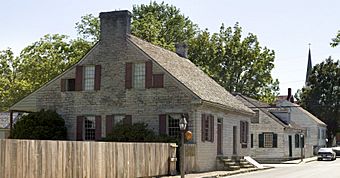Ste. Genevieve Historic District facts for kids
|
Ste. Genevieve Historic District
|
|

Felix Vallé State Historic Site, within the historic district
|
|
| Location | Ste. Genevieve, Missouri |
|---|---|
| Built | 1750 |
| Architectural style | Colonial |
| NRHP reference No. | 66000892 and 02000357 |
Quick facts for kids Significant dates |
|
| Added to NRHP | October 15, 1966, boundary increase April 11, 2002 |
| Designated NHLD | October 9, 1960 |
The Ste. Genevieve Historic District is a special area in Ste. Genevieve, Missouri. It's known for its amazing old buildings and how the land was used long ago. This district is a National Historic Landmark District, which means it's super important to American history.
Ste. Genevieve was once a capital city! In the late 1700s, it was the main city for French Louisiana and later for Spanish Louisiana. This was before the United States owned this land.
What makes Ste. Genevieve so unique? It has many buildings built in special French colonial styles. Two main styles are poteaux en terre (meaning "posts in ground") and Poteaux-sur-sol (meaning "posts on sill"). Both styles use vertical logs for walls. In poteaux en terre, the logs go right into the ground. In poteaux-sur-sol, they sit on a strong wooden or stone base.
You can see these cool styles in buildings like the Beauvais-Amoureux House, the Felix Vallé House State Historic Site, and the Louis Bolduc House. The Louis Bolduc House is so important it's a National Historic Landmark all by itself!
In 2020, Ste. Genevieve became even more special. It was made into the Ste. Genevieve National Historical Park. This means it's now part of the U.S. national park system, helping to protect its history for everyone.
Ste. Genevieve's Early Days
Ste. Genevieve was started by French settlers around the 1750s. At that time, the land west of the Mississippi River was part of French Louisiana. It quickly became a very important town in the area.
Later, in 1763, the land became Spanish territory after the Treaty of Paris. Ste. Genevieve stayed a key center even under Spanish rule.
The first town site was about 3 miles (5 km) south of where it is today. But in 1785, a big flood badly damaged the town. So, over the next ten years, the people moved Ste. Genevieve to higher ground.
Many of the oldest buildings you see today were built after the move. The church, for example, was moved in 1793. Even the farms outside the town still look like they did back then, showing old French ways of planning land.
New People and New Industries
After the Louisiana Purchase in 1810, Americans started moving to Ste. Genevieve. As the 1800s went on, people from other countries also came. By the mid-1800s, many German-Americans lived in the city.
Later in the 1800s, making lime became a big business in Ste. Genevieve. Lime is used in building materials. In 1904, a railroad ferry started connecting Ste. Genevieve to Kellogg, Illinois. This helped the town grow even more.
Protecting Ste. Genevieve's History
People have known for a long time that Ste. Genevieve's old buildings are very important. In the 1930s, many buildings were carefully recorded by the Historic American Buildings Survey. The Bolduc House was even fixed up in the 1950s.
In 1960, the National Park Service looked at the area. This led to Ste. Genevieve becoming one of the first National Historic Landmark Districts in the country. This special title helps protect its history.
In 1980, the Park Service found the exact spot of the original town. For a long time, people thought the old town had been completely washed away by floods. The state of Missouri has also bought some of the oldest buildings. They are now preserved as historic sites for everyone to visit and learn from.
The National Historic Landmark designation was updated in 1970. It now covers about 1,200 acres (485 hectares). This includes much of the town and the river bottomlands. These areas show how the French colonists used the land.
In 2002, another important step was taken. A separate listing was made for the city on the National Register of Historic Places. This listing focuses on the town's history from about 1790 to 1950.
On March 23, 2018, the National Park Service was allowed to create the Ste. Genevieve National Historical Park. This was a big step towards protecting the town's amazing past. Finally, on October 30, 2020, the park officially became the 422nd unit of the National Park System.



